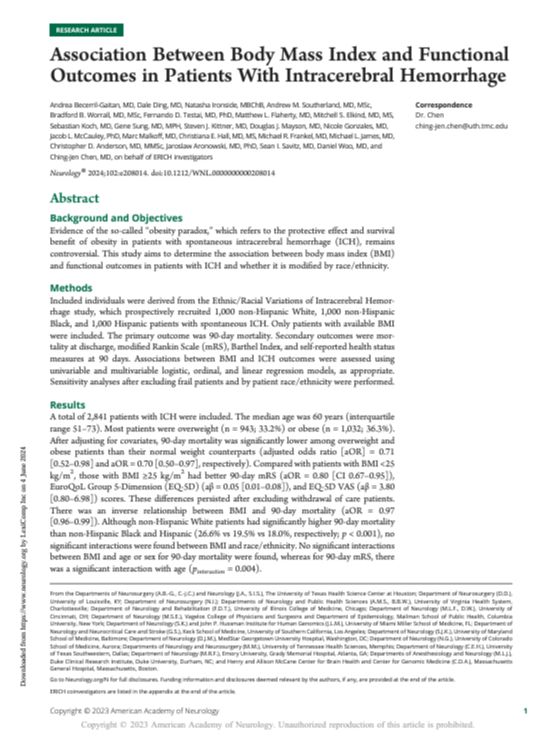Association Between Body Mass Index and Functional Outcomes in Patients With Intracerebral Hemorrhage
December 2023
Abstract
Background and Objectives
Evidence of the so-called “obesity paradox,” which refers to the protective effect and survival benefit of obesity in patients with spontaneous intracerebral hemorrhage (ICH), remains controversial. This study aims to determine the association between body mass index (BMI) and functional outcomes in patients with ICH and whether it is modified by race/ethnicity.
Methods
Included individuals were derived from the Ethnic/Racial Variations of Intracerebral Hemorrhage study, which prospectively recruited 1,000 non-Hispanic White, 1,000 non-Hispanic Black, and 1,000 Hispanic patients with spontaneous ICH. Only patients with available BMI were included. The primary outcome was 90-day mortality. Secondary outcomes were mortality at discharge, modified Rankin Scale (mRS), Barthel Index, and self-reported health status measures at 90 days. Associations between BMI and ICH outcomes were assessed using univariable and multivariable logistic, ordinal, and linear regression models, as appropriate. Sensitivity analyses after excluding frail patients and by patient race/ethnicity were performed.
Results
A total of 2,841 patients with ICH were included. The median age was 60 years (interquartile range 51–73). Most patients were overweight (n = 943; 33.2%) or obese (n = 1,032; 36.3%). After adjusting for covariates, 90-day mortality was significantly lower among overweight and obese patients than their normal weight counterparts (adjusted odds ratio [aOR] = 0.71 [0.52–0.98] and aOR = 0.70 [0.50–0.97], respectively). Compared with patients with BMI <25 kg/m2, those with BMI ≥25 kg/m2 had better 90-day mRS (aOR = 0.80 [CI 0.67–0.95]), EuroQoL Group 5-Dimension (EQ-5D) (aβ = 0.05 [0.01–0.08]), and EQ-5D VAS (aβ = 3.80 [0.80–6.98]) scores. These differences persisted after excluding withdrawal of care patients. There was an inverse relationship between BMI and 90-day mortality (aOR = 0.97 [0.96–0.99]). Although non-Hispanic White patients had significantly higher 90-day mortality than non-Hispanic Black and Hispanic (26.6% vs 19.5% vs 18.0%, respectively; p < 0.001), no significant interactions were found between BMI and race/ethnicity. No significant interactions between BMI and age or sex for 90-day mortality were found, whereas for 90-day mRS, there was a significant interaction with age (pinteraction = 0.004).
Conclusion
We demonstrated that a higher BMI is associated with decreased mortality, improved functional outcomes, and better self-reported health status at 90 days, thus supporting the paradoxical role of obesity in patients with ICH. The beneficial effect of high BMI does not seem to be modified by race/ethnicity or sex, whereas age may play a significant role in patient functional outcomes.

